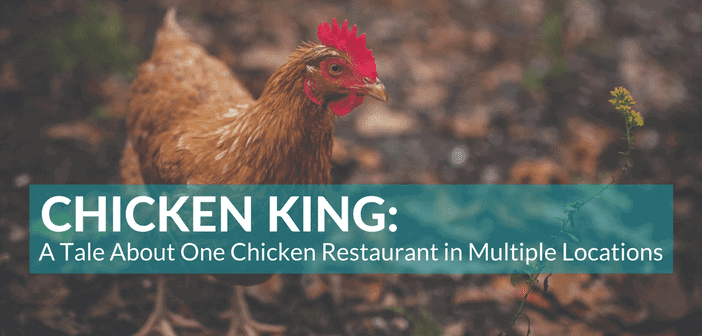Once upon a time…
In a far off land there was a restaurant which, for today’s purposes, we will call Chicken King. The Chicken King restaurant had been operating as a single location for quite some time. They still sold a lot of chicken sandwiches, but sales and profits were declining.
Rather than address the slowing sales and declining profits at their existing restaurant, the owner decided that the best solution was to open a second location. In fact, he rallied all his customers one day and announced, “We will have five locations in five years.” At that point, one of the customers asked for a refill on her Diet Coke.
After the big announcement, the owner got in his car and drove down the road, scouting out a possible second location, and found a vacant store. It was only about 15 minutes from the existing restaurant. At first he thought, “this might be a little too close to our existing location,” but the building was perfect and, more importantly, it was cheap and would be easy to retrofit.
The Next Big Task
The next big task was to decide who would lead the new location. The owner selected the young man he had hired a couple of years ago to head up the kitchen. This young man loved to cook, and he was starting to pressure the owner for more opportunities to serve chicken sandwiches to the adult customers. Up until now, he primarily served chicken sandwiches to the teenage customers and only on Wednesday evenings. In this limited capacity, he also didn’t have a whole lot of experience building teams or managing the balance of the restaurant operations, but he had a lot of passion and sensed it was time. Some might even refer to it as a calling to lead his own restaurant location.
Now the owner had a location and a leader. It was time to prepare for the grand opening. That’s when the challenges really began to surface. For one thing, the restaurant owner already had gaps in leadership and other positions that he hadn’t been able to fill at the original location. He was frequently scrambling to fill all the shifts and many times had to operate short-staffed. As with many restaurants, the biggest challenge always seemed to be finding people to work in the children’s play area. Because of that, the owner started requiring parents with kids in the play area to also work in the play area once a month.
The shortage of workers and leaders was being compounded now by the fact that his young kitchen leader was leaving to open the other location. The owner had no development or mentoring system in place, so no one was ready to step into that kitchen leader role. That’s the moment the owner realized that opening multiple restaurant locations exasperates the problems associated with a lack of leadership development and intentional team building. It’s as if the owner hoped that leaders would somehow magically show up at his door without any intentional strategy.
A New Community
About the time he was trying to figure out what to do about the staffing challenges, his young location manager walked into his office. The young man started to explain to the owner that the new store is going to be located in a different community. Though there are some similarities to the existing location, the new restaurant will be in a completely different culinary context. Therefore, the young location manager was pressing the owner for autonomy at the new restaurant location. In other words, he wanted to make some changes.
In the back of his mind, the owner was thinking, “But the new restaurant will only be 15 minutes away. How different could the two communities be?” Not wanting to come across as a micro-manager, though, the owner agreed to empower his young protege and allow him a lot of latitude when it came to serving chicken at the new location.
That was the green light the new manager wanted. The new location would still be called Chicken King, but in order to reach new customers in a new community, there would have to be some changes. As an example, the new location would have to offer a slightly different style of sauce on the chicken sandwich. The cooks at the new location would also need about 10 minutes longer to prepare the chicken. (Let that idea marinate for a moment). In fact, rather than just serving the chicken sandwiches to the customers, the cooks will take a bit more of an expository approach by explaining the recipe that was used–ingredient by ingredient. Apparently millennial customers prefer this.
Too Late to Go Back
The owner was beginning to wonder what he was getting into, but then he recalled that moment when he was casting the vision for five locations in five years. He already made that commitment to all his staff and his customers. He remembered the excitement it generated and all of the financial resources he raised from investors to open the second location. It was too late to go back.
The team pressed on and opening day finally arrived. That was a fun day. Lots of people showed up to check out the new store. And then the day after opening day arrived. And then the day after that. And the day after that. Wouldn’t opening a second location be fun if it were only about the grand opening?
Before long, most of the customers who initially indicated that they would start buying chicken sandwiches at the new location started to find their way back to the original location. They felt more comfortable with the original chicken sandwich. Now both locations were struggling to maintain sales and profitability.
Though the owner often said, “we are one restaurant in two locations,” he had a sense something wasn’t quite right. Why would customers be leaving the new location to come back to the original location? Why wasn’t the new location reaching new customers? Why was the original location still in decline?
He thought, “Isn’t multisite supposed to be the magic bullet for growth?”
Wanting to see for himself, the owner got into his car and drove over to the second location. He hadn’t been there since the grand opening. You can’t blame him. It’s impossible for the owner, the top leader and vision-caster, the person who primarily served chicken sandwiches at the original location, to be in two places at the same time. The only thing that would make that possible is if somehow the owner could serve chicken sandwiches by video to multiple locations. Even if the technology was available, people consuming content through streaming video? That idea, like the chickens served in his sandwiches, will never fly.
When the owner arrived at the second location, it didn’t take him long to identify why the restaurant wasn’t taking off. Here’s what he discovered:
-
- The customers showed up to the new location thinking they were going to Chicken King. When they arrived, they found a restaurant serving a different style of chicken sandwich from a completely different menu.
-
- It was easy for customers to bypass the new location because the original location was only 15 minutes away. Besides, it’s at the original location that the owner, himself, serves the chicken sandwiches. They have a bigger children’s play area. Some customers also tend to prefer the acoustic remakes of Chris Tomlin songs that play through that location’s sound system.
-
- Because the second location was smaller with fewer staff, they had a smaller menu and they weren’t open on Tuesdays, Thursdays and Saturdays.
-
- The staff at the second location encouraged customers to go back to the original location if they wanted one of the menu items, like the special men’s or women’s meals, that are only available at the original location.
-
- The owner thought that adding multiple locations would create synergy and increase profitability, but giving the second restaurant a lot of autonomy to do their own thing actually made the business more complex and increased the overall costs.
- Though there was a lot of alignment with the young location manager, the fit with the restaurant’s DNA was just a little bit off at its launch. The longer the restaurant was open, the bigger that gap grew…especially as the young location manager built his own team and attracted his own customers to his own style of chicken sandwich.
After his visit to the second location, the Chicken King owner realized he had a huge problem. Without anyone intentionally setting out to do this, the second location had become a completely different restaurant. Because of that, the restaurant chain had more expenses with more staff and more complexity. Not only was the original location unhealthy, it was in decline. It had stopped reaching new customers and the addition of the second location just magnified the problems.
The Chicken King owner began to reflect on how he got to this place and he struggled to identify what went wrong. After all, he once attended a conference where the leader of another mega-restaurant inspired other restaurant owners to go multisite. He had read a number of blog posts written by multisite restaurant owners. Each year, Fast Food Magazine develops a list of the fastest-growing restaurants in the country, and all the largest and fastest-growing restaurants are using a multisite strategy. The Chicken King owner had even visited a couple of Chick-fil-A restaurants to experience multisite firsthand.
Unfortunately, that wasn’t enough to find success. Among other things, he didn’t realize it’s one thing to have a clear, compelling vision for multisite. It’s something completely different to have a focused strategy for how that multisite vision will get accomplished. All he ever really wanted was for more people to experience the chicken that he was selling. He had no idea that his passion couldn’t make that happen.
Now, to put your minds at ease, this is just a fairy tale about a chicken restaurant and a prince of an owner. I’m sure nothing like this would ever happen in church ministry.
It’s also too bad that The Unstuck Group serves churches and not Chicken Kings. If we did, we could have helped that restaurant owner with a readiness assessment to determine how to get the original location “unstuck” before attempting to open a second location. Then we could have helped the team develop a strategy to maintain health and growth as it expands to one restaurant in multiple locations. That’s the type of help we provide churches, but, unfortunately, we don’t do much work with chicken restaurants.
Multisite happily ever afters only happen when a healthy, growing church has a strategy for growth to multiple locations.






